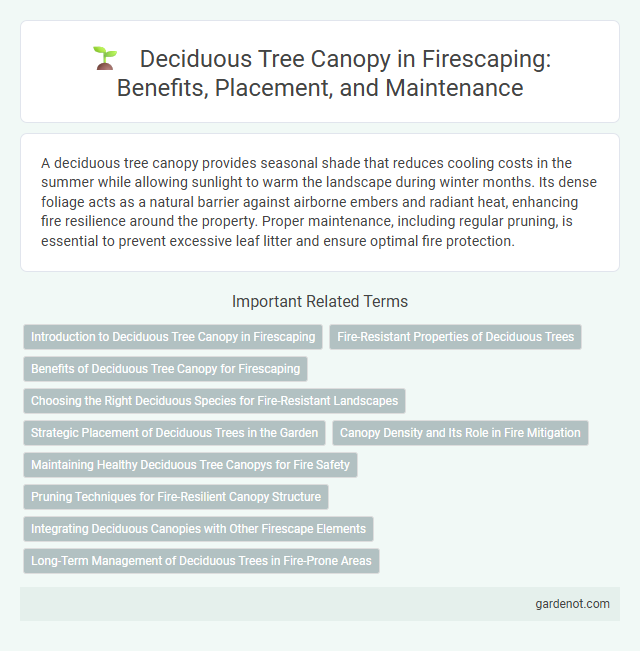A deciduous tree canopy provides seasonal shade that reduces cooling costs in the summer while allowing sunlight to warm the landscape during winter months. Its dense foliage acts as a natural barrier against airborne embers and radiant heat, enhancing fire resilience around the property. Proper maintenance, including regular pruning, is essential to prevent excessive leaf litter and ensure optimal fire protection.
Introduction to Deciduous Tree Canopy in Firescaping
Deciduous tree canopies play a crucial role in firescaping by influencing fire behavior and landscape safety during wildfire events. Their seasonal foliage changes reduce fuel loads in the fall and winter, decreasing fire intensity and spread risk. Proper management of deciduous tree canopies helps create defensible spaces and improves overall fire resilience in residential and wildland interface areas.
Fire-Resistant Properties of Deciduous Trees
Deciduous tree canopies exhibit significant fire-resistant properties due to their broad, moist leaves that tend to retain higher moisture content compared to coniferous species, reducing flammability. Their seasonal leaf drop minimizes available fuel on the tree itself, lowering the risk of crown fires and aiding in fire management within landscapes. Species such as oak (Quercus spp.) and maple (Acer spp.) provide effective natural firebreaks in firescaping by maintaining canopy moisture and creating less combustible environments.
Benefits of Deciduous Tree Canopy for Firescaping
Deciduous tree canopy provides significant benefits for firescaping by reducing wildfire intensity through seasonal leaf drop, which limits available fuel during fire-prone months. These trees create natural firebreaks by maintaining higher moisture content in their leaves compared to evergreen species, slowing fire spread across landscapes. Their broad canopies also provide shading that reduces ground vegetation growth, further decreasing combustible materials near structures.
Choosing the Right Deciduous Species for Fire-Resistant Landscapes
Selecting fire-resistant deciduous tree species such as oaks (Quercus spp.) and maples (Acer spp.) enhances landscape safety by reducing flammable fuel loads. These species have lower resin content and retain less dead wood, minimizing fire intensity and spread. Proper spacing and pruning of the deciduous canopy further increase fire resistance by improving airflow and reducing ladder fuels.
Strategic Placement of Deciduous Trees in the Garden
Strategic placement of deciduous trees in the garden enhances firescaping by providing seasonal shade that reduces ground temperatures in summer while allowing sunlight to warm the soil in winter. Positioning these trees near structures or along property lines creates effective fuel breaks, limiting fire spread by reducing continuous flammable vegetation. Selecting species with high moisture content and minimal volatile oils further improves fire resistance in the landscape design.
Canopy Density and Its Role in Fire Mitigation
Deciduous tree canopy density significantly influences fire behavior by reducing the amount of available fuel and limiting the intensity of wildfires. A dense canopy creates a moister microclimate beneath, lowering the likelihood of fire ignition and spread due to higher humidity levels and reduced sunlight penetration. Managing canopy density through strategic thinning and pruning optimizes fire mitigation by disrupting continuous fuel ladders and minimizing surface fire intensity.
Maintaining Healthy Deciduous Tree Canopys for Fire Safety
Maintaining healthy deciduous tree canopies involves regular pruning to remove dead or diseased branches, reducing combustible material that can fuel wildfires. Proper canopy spacing improves air circulation and limits fire spread by creating natural firebreaks. Ensuring adequate moisture through mulching and irrigation supports tree resilience, decreasing vulnerability during fire season.
Pruning Techniques for Fire-Resilient Canopy Structure
Effective pruning techniques for deciduous tree canopies enhance fire resilience by removing lower branches and thinning dense foliage, reducing ladder fuels that facilitate fire spread. Maintaining a well-spaced canopy structure improves air circulation and limits heat accumulation, minimizing the risk of crown fires. Strategic pruning during dormant seasons supports healthy growth while creating defensible space critical in fire-prone landscapes.
Integrating Deciduous Canopies with Other Firescape Elements
Integrating deciduous tree canopies with other firescape elements enhances wildfire resilience by creating strategic fuel breaks that slow fire spread and reduce intensity. The broad, moisture-rich leaves of deciduous trees contribute to lower surface temperatures and increased humidity, complementing fire-resistant ground covers and hardscape features. Positioning these canopies near driveways, patios, or within mixed-species plantings optimizes both aesthetic and protective functions in firescaping design.
Long-Term Management of Deciduous Trees in Fire-Prone Areas
Deciduous tree canopy management in fire-prone areas requires strategies that enhance fire resistance while preserving ecological benefits. Long-term practices include regular pruning to reduce ladder fuels, strategic thinning to maintain canopy separation, and selecting fire-adapted species that promote resilience. Integrating fire-wise landscaping techniques minimizes wildfire risks and supports sustainable forest health.
Deciduous tree canopy Infographic

 gardenot.com
gardenot.com